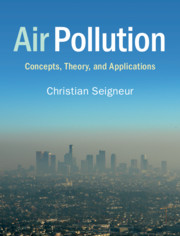Book contents
- Air Pollution
- Air Pollution
- Copyright page
- Contents
- Preface
- Main Notations
- 1 Brief History of Air Pollution
- 2 Emissions of Air Pollutants and Emission Control Technologies
- 3 Meteorology: General Circulation
- 4 Air Pollution Meteorology
- 5 Atmospheric Radiative Transfer and Visibility
- 6 Atmospheric Dispersion
- 7 The Stratospheric Ozone Layer
- 8 Gaseous Pollutants
- 9 Atmospheric Particles
- 10 Clouds and Acid Rain
- 11 Transfer of Pollutants between the Atmosphere and Surfaces
- 12 Health Effects
- 13 Environmental Impacts
- 14 Climate Change and Air Pollution
- 15 Regulations and Public Policies
- Index
- References
14 - Climate Change and Air Pollution
Published online by Cambridge University Press: 19 June 2019
- Air Pollution
- Air Pollution
- Copyright page
- Contents
- Preface
- Main Notations
- 1 Brief History of Air Pollution
- 2 Emissions of Air Pollutants and Emission Control Technologies
- 3 Meteorology: General Circulation
- 4 Air Pollution Meteorology
- 5 Atmospheric Radiative Transfer and Visibility
- 6 Atmospheric Dispersion
- 7 The Stratospheric Ozone Layer
- 8 Gaseous Pollutants
- 9 Atmospheric Particles
- 10 Clouds and Acid Rain
- 11 Transfer of Pollutants between the Atmosphere and Surfaces
- 12 Health Effects
- 13 Environmental Impacts
- 14 Climate Change and Air Pollution
- 15 Regulations and Public Policies
- Index
- References
Summary
Climate change is a major issue regarding the atmospheric environment. It differs from air pollution in spatial and temporal scales. Climate change is due mostly to greenhouse gases that have long atmospheric lifetimes and, therefore, are distributed relatively uniformly in the atmosphere. To the contrary, air pollution shows great spatio-temporal variability and offers a relatively short response time in terms of the relationship between emissions and atmospheric concentrations. Nevertheless, there are many links between climate change and air pollution. First, some air pollutants contribute to climate change. Second, climate change may affect air pollution. Finally, some sources emit both air pollutants and greenhouse gases, whereas other sources may emit mostly air pollutants or mostly greenhouse gases. Therefore, it is essential to identify all the emissions associated with a given source in order to avoid creating one problem when trying to solve another. This chapter first summarizes in general terms the main aspects of climate change and then describes the interactions between climate change and air pollution.
- Type
- Chapter
- Information
- Air PollutionConcepts, Theory, and Applications, pp. 318 - 326Publisher: Cambridge University PressPrint publication year: 2019



